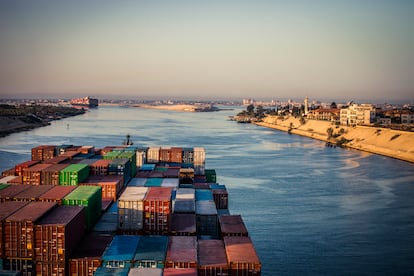Egypt wants to lead the green hydrogen revolution
The country wants to take advantage of its capacity to generate renewable energy and the organization of the COP27 to become a large producer

The development of green hydrogen has recently become one of the main bets among promoters of the energy transition as one of the clean fuels that will sustain the economy of the future, and Egypt does not want to be left out of the action. Taking advantage of a privileged starting point and location, as well as the organization of the UN climate change conference (COP27) in November, in the last year Cairo has redoubled its efforts to develop this industry, and the country is beginning to establish itself as one of the best positioned in the region to capitalize on this collective enthusiasm.
Hydrogen is produced emission-free from the electrolysis of water, a process which consists of applying an electric current that separates hydrogen and oxygen, retaining the former and releasing the latter into the air. In order for it to be green hydrogen, the electricity used to break down the water must be generated from renewable sources.
Egypt’s plan to become a regional hub for the production of green hydrogen is part of a broader strategy to develop sources of green energy that has been promoted since the agreement of decarbonization established in 2015 at COP21, in Paris. Under this premise, Egyptian president Abdel Fattah El-Sisi ordered the creation of a strategy to develop the green hydrogen industry in mid-2021. Since then, Cairo has designated the strategic Suez Canal Economic Zone (SCZone) as the place to install this nascent industry, with the support of the ministries of Petroleum and Electricity and Renewable Energy, in addition to the Sovereign Fund of Egypt.
A large part of the international trade passes through the Economic Zone, which makes it a good position from which to start discussions with the world’s major players on how to establish plans for green hydrogen production, taking advantage of the industrial zone and the Sokhna port in the Gulf of Suez, says Yehia Zaki, president of the SCZone.
The factors that put Egypt in a privileged position to develop the green hydrogen industry are its abundant and cheap renewable energy sources, particularly solar and wind power; its infrastructure, gas in particular, as well as the Suez Canal; a domestic market with the capacity to absorb part of the initial production; and a strong political will. Proof of the latter is how the government is developing a national hydrogen strategy with the European Bank for Reconstruction and Development (EBRD).
Heike Harmgart, managing director for the southern and Eastern Mediterranean at the EBRD, points out that Egypt is exceptionally well placed, standing out – along with Morocco – in their analysis of the potential of green hydrogen in the southern and eastern Mediterranean region. Across all factors, Egypt does incredibly well on the global stage.
Egypt is in an ideal position to take advantage of the growing global interest in green hydrogen and ammonia production, agrees Peter Stevenson, East Mediterranean editor at Middle East Economic Survey, a publication specializing in the energy industry. Besides the hub that the country has already built around Ain Sokhna and the Suez Canal Economic Zone, where it offers various services, the Red Sea is a perfect place for renewable energies, especially wind power.
The best indication that Egypt is heading in the right direction is the interest it has already generated in the private sector. So far, Cairo has signed eight memorandums of understanding with several companies and consortiums to carry out feasibility studies on future production projects, and Zaki anticipates that three or four more could be sealed in the coming months. According to the data provided by the SCZone, the total investment cost contemplated in the memorandums as a whole amounts to 28 billion dollars. Among the signatory companies are the French Total and the Danish Maersk.
When some of these deals come to fruition, the first projects to be carried out will be primarily aimed at using green hydrogen to produce ammonia for fertilizers and green fuel for ships, Zaki and Harmgart explain. Zaki also trusts that they will be export-oriented; Europe has determined that by 2030 it will need 20 million tons of green hydrogen per year, and while 10 million will be produced in Europe, it will be necessary to import the other ten. Egypt would be highly suitable for that purpose.
Harmgart, for her part, says that while the potential for exports is much higher, some of the pilot projects will initially be destined for domestic use, as they will require less infrastructure, and for European importers of green hydrogen, it would be very reassuring to see that Egypt has piloted green ammonia for the fertilizer industry. That is a good sign to make a long-term plan.
Already underway
At the moment, the only project that has already started is the development of a green hydrogen plant promoted by Scatec, a Norwegian company specialized in renewable energy, the Egyptian company specialized in fertilizers Fertiglobe and the construction company Orascom, with the cooperation of the Sovereign Fund of Egypt. Zaki mentions that they expect it to become first model of the industry in the country.
Scatec also signed one of the memorandums of understanding with Cairo, for a green ammonia plant. CEO Terje Pilskog explains that the company is developing large-scale green hydrogen and ammonia projects with the goal of taking a leadership position in this part of the industry.
As for Egypt, after the interest for the development of the industry has been established, their main challenge is to make the investments a reality. Their goal, Zaki says, is to start producing in 2026.
Tu suscripción se está usando en otro dispositivo
¿Quieres añadir otro usuario a tu suscripción?
Si continúas leyendo en este dispositivo, no se podrá leer en el otro.
FlechaTu suscripción se está usando en otro dispositivo y solo puedes acceder a EL PAÍS desde un dispositivo a la vez.
Si quieres compartir tu cuenta, cambia tu suscripción a la modalidad Premium, así podrás añadir otro usuario. Cada uno accederá con su propia cuenta de email, lo que os permitirá personalizar vuestra experiencia en EL PAÍS.
¿Tienes una suscripción de empresa? Accede aquí para contratar más cuentas.
En el caso de no saber quién está usando tu cuenta, te recomendamos cambiar tu contraseña aquí.
Si decides continuar compartiendo tu cuenta, este mensaje se mostrará en tu dispositivo y en el de la otra persona que está usando tu cuenta de forma indefinida, afectando a tu experiencia de lectura. Puedes consultar aquí los términos y condiciones de la suscripción digital.
More information
Últimas noticias
Aquilino Gonell, former Capitol sergeant: ‘If it hadn’t been for the police, the US would be a dictatorship’
A hybrid building: Soccer pitch, housing, and a shopping mall
Europe urges Trump to respect Greenland following annexation threats
Science seeks keys to human longevity in the genetic mixing of Brazilian supercentenarians
Most viewed
- Alain Aspect, Nobel laureate in physics: ‘Einstein was so smart that he would have had to recognize quantum entanglement’
- Mexico’s missing people crisis casts a shadow over World Cup venue
- Alvin Hellerstein, a 92-year-old judge appointed by Bill Clinton, to preside over Maduro’s trial in New York
- Why oil has been at the center of Venezuela-US conflicts for decades
- Cuba confirms death of 32 of its citizens in the US attack against Venezuela











































